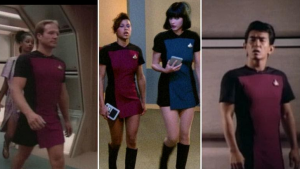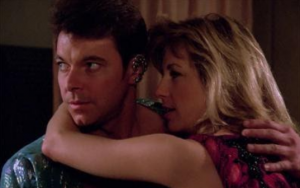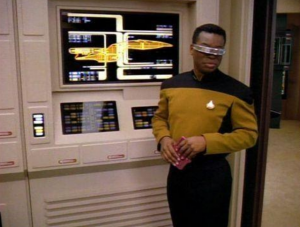18 Star Trek: The Next Generation (1987-1994)
Star Trek: The Next Generation: Representation in the Final Frontier
By Aiden Jones
I first knew I had fallen in love with Star Trek: The Next Generation when I spotted a male background character sporting the stylish mini-skirted version of Starfleet’s uniform (canonically known as the “skant” – reminiscent of modern-day “skorts”). Despite the later removal of these dress-wearing men, I have continued to be surprised by the show’s progressive representation of minorities, often ahead of its time. In contrast with the original Star Trek of the 1960s, described by Lee Jutton of Just Press Play as, “campy, comical and somewhat dated, with special effects that could be done by an enthusiastic group of kids in their garage,” The Next Generation’s more serious tone allows it to have more in-depth conversations of gender and race. Not only is the show more racially diverse, it is also more common to find women in positions of power. Although this representation is often ahead of its time, the show isn’t without its flaws. Instead of facing issues of discrimination head-on, they are often presented under the guise of human/alien conflict. The starship Enterprise’s highest positions are almost exclusively held by white men. Despite their increased presence, women are still depicted as fragile and feminine, often in need of help from a male officer. In addition, there are almost no substantial depictions of LGBTQ individuals. This mixture of attempted representation and underlying cultural biases make for an interesting mix of encoded progressive and conservative sentiments.

Despite its increased viewership and budget, Star Trek: The Next Generation is a product of its time. In addition to its laughable ideas of futuristic technology and often cheesy visual effects, many outdated unconscious biases of its creators are ingrained in its writing and visual design. Although they are depicted in positions of power more often, women are still generally written as soft, kind, and emotional while male crew members are written as more level-headed and practical. For example, Deanna Troi, in addition to holding the stereotypically feminine position of a caretaker through her job as ship counselor, is also an “empath” – able to sense the emotions of those around her. She is also the crew’s most fashionable member, almost never shown wearing the traditional Starfleet uniform. Instead, she is costumed in many different tight, revealing outfits and accessorized with sparkling jewels in her hair to accent her femininity. When a woman is written as less feminine, it’s to serve a point about her personality. For example, Tasha Yar, the Enterprise’s Head of Security during season 1, is coded as less feminine than other female characters due to her traditionally masculine profession and serious demeanor. It’s clear that the show’s writers are making an effort to be more inclusive – but their inherent biases are obvious all the same.
While The Next Generation’s racial representation is arguably more developed than its gender representation, underlying stereotypes can still be easily found. The Enterprise’s crew is overwhelmingly white and male, with few people of color among the ship’s highest-ranking officers. The ship’s captain, Jean-Luc Picard is a white man of French origin and often romanticizes the works of traditional white European authors such as Shakespeare. When the crew encounters a god-like being capable of choosing any form named “Q”, he is portrayed, again, as a white man. When issues of race are discussed, the show has a habit of disguising them as human/alien relations. Most alien races encountered in the series are light-skinned, however, some appear to be derivative of harmful stereotypes: violent and tribal dark-skinned Klingons, villainous and greedy goblin-like Forengi, and stoic, logical Vulcans and Romulans depicted in Asian-inspired costumes.
As a whole, many science fiction stories tend to steer away from direct representations of sexuality, especially the nontraditional. Those that are present in Star Trek: The Next Generation are overwhelmingly straight. As stated by Lee Heller, “TNG tried to imagine utopian romantic configurations and ideal sexual others, only to tell us, first, that such relationships are necessarily heterosexual.” Despite The Next Generation’s purported progressive attitude, the only romances shown on screen are straight ones. In addition, romances are almost always male-dominated. For example, even on the matriarchal planet Angel One, Commander William Riker is dominant over its ruler when the two enter a steamy relationship. This heteronormativity is nothing new to the Star Trek franchise – The lack of non-hetero romance in the original series lead to the birth of the first “slash fiction” – fan fiction focused on gay romance. When denied representation, people will find or create it for themselves.

Despite some loosening of gender roles as in the case of the “skant”, there is an almost-complete lack of gender nonconforming and transgender characters in The Next Generation. In fact, the removal of the skant-wearing male background characters before the end of the first season serves to signal the audience’s general discomfort with this concept. When gender differences are portrayed, they are always through alien cultures, reinforcing their difference from the social norm. However, even among alien cultures, where it seems obvious differences in gender should exist, they are incredibly rare. When the atypical gender nonconforming alien does appear, they are generally coded as masculine or feminine, especially in the context of a romantic relationship. One season 5 episode, “The Outcast”, exemplifies this perfectly. When Commander Riker and a genderless alien fall in love, the show defaults to feminizing the previously androgynous alien in relation to their new relationship. According to Jump Cut’s Elspeth Kydd, “One of the many displacements at work in this episode is to displace onto an alien species any potential discussion of transgendered humans or questioning of the problems inherent in bipolar gendered humanity. It presents heterosexuality and unproblematic male/ female gender identification as the norm for humanity, as well as a desirable goal for non-humans.” In this way, The Next Generation constantly works to reinforce heterosexual, cisgender relationships as the only acceptable choice.
After all this negativity, you may be wondering: why should anyone care about this show? The answer is that it’s greater than the sum of its own parts – the Star Trek franchise has had a deep impact on science fiction media as a whole and served to break many barriers both within and beyond the genre. For instance, the original 1960s Star Trek is famous for featuring the first interracial kiss broadcast on television. Although previous examples have since been uncovered, this achievement in representation is notable for its widespread viewership. In The Next Generation, the few minority crew members present are shown to be well-rounded characters with thoughts and desires separate from their gender and skin color, despite the presence of stereotyping. Despite its flaws, the Star Trek franchise has been an influential force in the genre of science fiction, often leading the way in representation. Even if this early representation is flawed, it’s a necessary starting point.

In spite of its often-confused representation, Star Trek: The Next Generation also manages to get a lot right. For instance, the people of color aboard the Enterprise are developed and individual characters. They have their own lives, struggles, dreams, and families. Head Engineer Geordi La Forge is my personal favorite example of this. Incredibly smart and loyal, he is brave to a fault and willing to risk his life to save his fellow crew members. When another character has a problem with anything mechanical, they know to go to Geordi first. In combination with android Commander Data and child prodigy Wesley Crusher, he is seemingly able to solve any problem presented to the crew of the starship. His identity as a blind black man doesn’t factor into his worth, he is simply an incredible person and that’s what people care about most. Additionally, his mother, Silvia La Forge, is a Starfleet captain in charge of her own ship. Two other examples are the enigmatic barkeeper Guinan and tactical officer Worf. Guinan, played by Whoopi Goldberg, is often hinted to be the crew’s most ancient and powerful member. She is wise and charming, holding many secrets about her long life. However, she is also lighthearted and caring, present for everyone to talk to when they need advice. Worf, despite his Klingon temper, is repeatedly shown to be honorable and kindhearted. When he sees a young boy aboard the Enterprise become orphaned following his mother’s death, the empathetic Worf, also an orphan, decides to take the boy into his own family and care for him. While crew members of color are rarer than their white counterparts, they are incredibly well-rounded when they do appear.

Female characters, despite their frequent reliance upon male assistance, are also written with unique care. Their status as women is rarely called into question in a direct manner, even if it is insinuated or used as a convenient plot point. For example, in one first-season episode, the crew is exposed to a gas that, among other effects, increases their sexual desire. The episode centers around many different female crew members’ desires for their male counterparts. However, regardless of these frequent underlying stereotypes, women in Star Trek: The Next Generation are depicted in positions of power more than ever before. Despite her character flaws, Deanna Troi is an integral part of the Enterprise’s crew. She is often able to see the true intentions of hostile aliens before they become apparent to anyone else aboard, giving the crew a distinct advantage. Both of the ship’s doctors, Dr. Beverly Crusher and Dr. Katherine Pulaski, are strong-minded and intelligent women, capable of handling themselves in most situations. (unless the episode’s plot calls for a rescue mission) Additionally, many female side characters are shown to be rulers or important politicians. The next series in the franchise, Star Trek: Voyager, would even introduce a female captain of the Enterprise, Kathryn Janeway.
My love of Star Trek: The Next Generation does not make it immune to criticism. Its progressive record is covered in the stains of stereotype. It’s important that we don’t forget these dark spots, as they continue to affect today’s media. However, I think The Next Generation (and Star Trek as a whole) should be appreciated for everything it’s done for sci-fi representation. It gave us a necessary starting point to progress and improve from, as proceeding Star Trek series would go on to do. The latest series, Star Trek: Discovery, even includes real, honest-to-God transgender and nonbinary characters, demonstrating the series’ ongoing dedication to representation.
Works Cited
Heller, Lee. “The Persistence of Difference: Postfeminism, Popular Discourse, and Heterosexuality in Star Trek: The Next Generation.” Science Fiction Studies, vol. 24, no. 2, pp. 226–244, SF-TH Inc, 1997, JSTOR, www.jstor.org/stable/4240605. Accessed 25 Nov. 2020.
Jutton, Lee. “The Season Star Trek: The Next Generation Grew into Its Own.” Just Press Play, 16 Jan. 2016, www.justpressplay.net/reviews/10654-star-trek-the-next-generation-season-three.html. Accessed 24 Nov. 2020.
Kydd, Elspeth. “Star Trek Insiders and ‘Outcasts’.” Jump Cut: A Review of Contemporary Media, vol. 42, pp. 39-44, 1998, ejumpcut.org/archive/onlinessays/JC42folder/StarTrekGender.html. Accessed 24 Nov. 2020.
Photo Sources
Black and disabled Head Engineer Geordi La Forge is one of the Enterprise’s most intelligent crew members. Digital Spy, www.digitalspy.com/tv/ustv/a797085/star-trek-levar-burton-comeback-for-bryan-fuller-spinoff/. Accessed 26 Nov. 2020.
Commander Riker seduces the matriarch of alien planet Angel One. The Greatest Generation Podcast Wiki, www.greatestgen.fandom.com/wiki/Riker%27s_Consent_Fetish. Accessed 27 Nov. 2020.
Skants for everyone! Change.org, www.change.org/p/cbs-bring-back-the-skant. Accessed 26 Nov. 2020.
TV’s “first” interracial kiss between Captain Kirk and Lieutenant Commander Uhura. Black Then, www.blackthen.com/the-first-interracial-kiss-in-television-history-was-between-star-treks-uhura-and-captain-kirk/. Accessed 26 Nov. 2020

